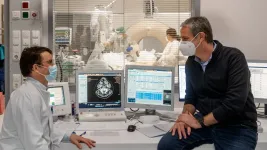Wearable devices show that physical activity may lower atrial fibrillation and stroke risk
The use of accelerometers enables researchers to provide the most objective evidence to date of the link between physical activity and atrial fibrillation.
2021-05-25
(Press-News.org) BOSTON - Physical activity that conforms to medical and health association guidelines is associated with a lower risk of atrial fibrillation (Afib) and stroke, according to a study by researchers at Massachusetts General Hospital (MGH), who analyzed nearly 100,000 individuals equipped with wrist-worn accelerometers to measure their movement. The researchers' findings suggest that data from wearables, including a new generation of devices with sensors that allow for Afib detection, could provide an opportunity for the public health community to promote moderate physical activity as an effective way to improve health outcomes. The study was published in the European Heart Journal. [1]
"Although some population-based studies have observed a lower risk of atrial fibrillation with exercise, the link has remained inconclusive in part because those studies relied on self-reporting by participants, a less than exact science," says senior author Steven Lubitz, MD, MPH, an investigator in the Division of Cardiology at MGH. "Wearable accelerometers, on the other hand, provide an objective and reproducible measure of physical activity. What we found was that activity in accordance with guideline recommendations is indeed associated with substantially lower risks of both atrial fibrillation and stroke."
Nearly 100,000 members of the UK Biobank agreed to wear accelerometers - electromagnetic devices that measure body movement and orientation to infer certain activities - for seven days. MGH researchers then compared that data with later diagnoses of atrial fibrillation and stroke among participants, most between 55 and 70 years of age, reported to the Biobank from 2013 to 2020.
"Our findings supported recommendations from the European Society of Cardiology, the American Heart Association, and the World Health Organization for 150 minutes or greater of moderate to vigorous physical activity per week," notes lead author Shaan Khurshid, MD, an investigator in the Division of Cardiology at MGH.
Given the explosive growth of "smart" devices with increasingly sophisticated detection capabilities, the study stressed the exciting opportunities that now exist to link disease prevention programs to atrial fibrillation diagnostics. Those devices include wearables and smartphones able to measure heart rate and thus detect possible arrhythmias and other irregularities through their photoplethysmography (a technique that detects changes in blood flow through sensors on the skin) and electrocardiographic (ECG) capabilities.
"It's not hard to imagine how these devices could be used by physicians and patients to achieve a level of physical activity which we know to be associated with a reduced risk of atrial fibrillation," explains Lubitz. "And by potentially identifying Afib through photoplethysmography and electrocardiography, users could be alerted to seek professional care before a stroke develops."
Lubitz is hopeful that these emerging technologies could be applied to not just Afib and stroke but also to other forms of cardiovascular disease, including hypertension, and to metabolic diseases like diabetes, which might be affected by guideline-adherent physical activity. "Wearable devices capable of objective activity monitoring, motivational messaging, and disease detection could be low-cost, highly effective interventions to improve health outcomes for countless numbers of people."
INFORMATION:
Lubitz is a cardiac electrophysiologist at MGH and associate professor of Medicine at Harvard Medical School. Khurshid is a clinical and research fellow in cardiology at MGH. Other co-authors include Emelia Benjamin, MD, ScM, professor of Medicine and Epidemiology at the Boston University Schools of Medicine and Public Health; Patrick Ellinor, MD, PhD, director of the Cardiac Arrhythmia Service at MGH; Ludovic Trinquart, PhD, associate professor of Biostatistics at Boston University School of Public Health; and David McManus, MD, chair of the Department of Medicine at University of Massachusetts Medical School.
The researchers were supported by the National Institutes of Health, the American Heart Association, and Robert Wood Johnson.
About the Massachusetts General Hospital
Massachusetts General Hospital, founded in 1811, is the original and largest teaching hospital of Harvard Medical School. The Mass General Research Institute conducts the largest hospital-based research program in the nation, with annual research operations of more than $1 billion and comprises more than 9,500 researchers working across more than 30 institutes, centers and departments. In August 2020, Mass General was named #6 in the U.S. News & World Report list of "America's Best Hospitals."
[1] "Accelerometer-derived physical activity and risk of atrial fibrillation", by Shaan Khurshid et al. European Heart Journal. doi:10.1093/eurheartj/ehab250.
ELSE PRESS RELEASES FROM THIS DATE:
2021-05-25
Digital medicine is opening up entirely new possibilities. For example, it can detect tumors at an early stage. But the effectiveness of new AI algorithms depends on the quantity and quality of the data used to train them.
To maximize the data pool, it is customary to share patient data between clinics by sending copies of databases to the clinics where the algorithm is being trained. For data protection purposes, the material usually undergoes anonymization and pseudonymization processes - a procedure that has also come in for criticism. "These processes have often proven inadequate in terms of protecting patients' health data," says Daniel Rueckert, ...
2021-05-25
From shamans and mystics to cult leaders and divine kings, why have people throughout history accorded high status to people believed to have supernatural powers?
According to a study led by researchers from the University of Oxford, this tendency to attribute social dominance to such individuals is rooted in early development.
As part of the study, 48 infants aged 12 to 16 months watched a series of animated videos in which two characters competed for a reward. In each scenario, one character displayed physically counterintuitive methods of making ...
2021-05-25
In a new publication from Opto-Electronic Advances; DOI https://doi.org/10.29026/oea.2021.200077, Researchers led by Professor Jeongyong Kim at the Department of Energy Science, Sungkyunkwan University, Suwon, Republic of Korea review light-emitting MXene quantum dots.
MXenes have found wide-ranging applications in energy storage devices, sensors, catalysis, etc. owing to their high electronic conductivity and wide range of optical absorption. However, the absence of semiconducting MXenes has limited their applications related to light emission.
Extensively reviewing current relevant research, the authors summarise recent advances in MXene quantum dot (MQD) research on the synthesis, optical properties and applications of MQDs as light emitting quantum materials. Research ...
2021-05-25
Graphene is an ultrathin material characterized by its ultrasmall bending modulus, superflimsiness. Now the researchers at the Nanoscience Center of the University of Jyväskylä have demonstrated how an experimental technique called optical forging can make graphene ultrastiff, increase its stiffness by several orders of magnitude. The research was published in npj 2D Materials and Applications in May 2021.
Graphene is an atomically thin carbon material loaded with excellent properties, such as large charge carrier mobility, superb thermal conductivity, and high ...
2021-05-25
When it comes to distinguishing a healthy cell from an infected one that needs to be destroyed, the immune system's killer T cells sometimes make mistakes.
This discovery, described today in eLife, upends a long-held belief among scientists that T cells were nearly perfect at discriminating friend from foe. The results may point to new ways to treat autoimmune diseases that cause the immune system to attack the body, or lead to improvements in cutting-edge cancer treatments.
It is widely believed that T cells can discriminate perfectly between infected cells and healthy ones based on how tightly they are able to bind to molecules called antigens ...
2021-05-25
About 14 billion years ago, our universe changed from being a lot hotter and denser to expanding radically - a process that scientists have named 'The Big Bang'.
And even though we know that this fast expansion created particles, atoms, stars, galaxies and life as we know it today, the details of how it all happened are still unknown.
Now a new study performed by researchers from University of Copenhagen reveals insights on how it all began.
"We have studied a substance called Quark-Gluon Plasma that was the only matter, which existed during the first microsecond ...
2021-05-25
A rare mutation that causes Parkinson's disease-like symptoms interrupts the flow of dopamine in the brain, suggests a study in fruit flies published today in eLife.
The findings provide more detailed insights about why young children with this mutation develop these symptoms. This new information, as well as previous evidence that therapies helping to improve dopamine balance in the brain can alleviate some symptoms in the flies, suggests that this could be a beneficial new treatment strategy.
Parkinson's disease causes progressive degeneration of the brain that leads to impaired movement and coordination. Current treatments focus on replacing or increasing the levels of dopamine to help reduce movement-related symptoms. But these drugs can have side ...
2021-05-25
Graphene nanoribbons (GNRs), narrow strips of single-layer graphene, have interesting physical, electrical, thermal, and optical properties because of the interplay between their crystal and electronic structures. These novel characteristics have pushed them to the forefront in the search for ways to advance next-generation nanotechnologies.
While bottom-up fabrication techniques now allow the synthesis of a broad range of graphene nanoribbons that feature well-defined edge geometries, widths, and heteroatom incorporations, the question of whether or not structural disorder is present in these atomically precise GNRs, and to what extent, is still subject to debate. The answer to this ...
2021-05-25
In the latest National Autism Indicators Report, researchers from Drexel University’s A.J. Drexel Autism Institute examined surveys of family members of autistic adults who use Developmental Disability services, and found needs for additional supports like respite care and assistance to plan for crisis and emergencies, especially among families whose adult lived with them.
Data from the surveys showed over one quarter of families with autistic adults who use Developmental Disability services and live with family do not have enough services or supports for themselves, according to the report. And over half of these families ...
2021-05-25
Staying up all night, working nonstop, eating on the run and skipping meals are often telltale signs of starting a new business. But research shows this constant hustle - which is often glorified as the key to success - can have a negative impact not only on an entrepreneur's health and well-being but also his or her business.
New research led by UCF assistant professor of management Jeff Gish suggests that engaging in recovery may help entrepreneurs reduce the negative impact of stress.
"Entrepreneurs who work really hard and grind on their business and who most ...
LAST 30 PRESS RELEASES:
[Press-News.org] Wearable devices show that physical activity may lower atrial fibrillation and stroke risk
The use of accelerometers enables researchers to provide the most objective evidence to date of the link between physical activity and atrial fibrillation.



